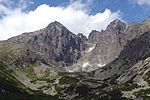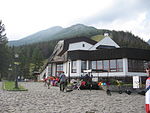The Tatra Mountains (pronounced ), Tatras, or Tatra (Tatry either in Slovak (pronounced [ˈtatri]) or in Polish (pronounced [ˈtatrɨ]) - plurale tantum), are a series of mountains within the Western Carpathians that form a natural border between Slovakia and Poland. They are the highest mountains in the Carpathians. The Tatras are distinct from the Low Tatras (Slovak: Nízke Tatry), a separate Slovak mountain range further south.
The Tatra Mountains occupy an area of 785 square kilometres (303 sq mi), of which about 610 square kilometres (236 sq mi) (77.7%) lie within Slovakia and about 175 square kilometres (68 sq mi) (22.3%) within Poland. The highest peak, called Gerlachovský štít, at 2,655 m (8710 ft), is located north of Poprad, entirely in Slovakia. The highest point in Poland, Rysy, at 2,499 m (8200 ft), is located south of Zakopane, on the border with Slovakia.The Tatras' length, measured from the eastern foothills of the Kobylí vrch (1109 m) to the southwestern foot of Ostrý vrch (1128 m), in a straight line, is 57 km (35 mi) (or 53 km (33 mi) according to some), and strictly along the main ridge, 80 km (50 mi). The range is only 19 km (12 mi) wide. The main ridge of the Tatras runs from the village of Huty at the western end to the village of Ždiar at the eastern end.
The Tatras are now protected by law by the establishment of the Tatra National Park, Slovakia and the Tatra National Park, Poland, which are jointly entered in UNESCO's World Network of Biosphere Reserves.
In 1992, UNESCO jointly designated the Polish and Slovak parks a transboundary biosphere reserve in the World Network of Biosphere Reserves, under its Man and the Biosphere Programme.











